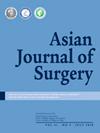乳房x光微钙化作为不同乳腺癌分子亚型新辅助疗效的预测因子
IF 3.5
3区 医学
Q1 SURGERY
引用次数: 0
摘要
微钙化是乳腺癌的重要指标,特别是用于区分不同的分子亚型。本研究旨在探讨乳腺癌新辅助化疗(NAC)患者治疗前检测到的微钙化与不同分子类型临床指标的关系。方法回顾性分析178例行NAC的乳腺癌患者的临床资料,共369例。根据乳房x光检查结果将患者分为微钙化组和非微钙化组。统计方法,包括卡方检验、t检验和非参数检验,用于比较存在和不存在微钙化的不同分子亚型的临床变量。此外,使用多变量分析和回归方程来确定微钙化预测her2阳性乳腺癌的能力。结果不同乳腺癌亚型间存在显著差异(X2 = 14.129, p <;0.001)和乳房手术类型(X2 = 5.073, p = 0.024)。乳房微钙化患者比无微钙化患者更有可能达到病理完全缓解(pCR) (p = 0.041),特别是her2阳性亚型,p = 0.004,奇比(OR) = 0.115, 95%可信区间(CI): 0.026-0.498)。相反,基底样亚型患者表现出相反的趋势(p = 0.002, OR = 15.000, 95.0% CI: 2.782-80.867)。残留癌负荷(RCB)分析结果与pCR结果一致。her2阳性亚型患者发生乳腺微钙化的可能性最高(X2 = 14.129, p <;0.001)。我们采用逻辑回归方程来预测her2阳性乳腺癌实现pCR的概率,总体预测准确率为82.72%。结论乳腺微钙化是NAC有效性的重要预测指标,尤其是分子亚型。在her2阳性乳腺癌中,微钙化与较高的pCR率和较低的RCB相关,但可能降低NAC在基底样乳腺癌中的疗效。乳腺微钙化对NAC疗效的预测价值对her2阳性乳腺癌的治疗具有重要的临床意义。本文章由计算机程序翻译,如有差异,请以英文原文为准。
Mammographic microcalcifications as a predictor of neoadjuvant efficacy across different breast cancer molecular subtypes
Introduction
Microcalcifications are significant indicators of breast cancer, particularly for distinguishing the different molecular subtypes. This study aimed to investigate the relationship between microcalcifications detected before treatment and various clinical indicators across different molecular types in breast cancer patients undergoing neoadjuvant chemotherapy (NAC).
Methods
In this retrospective study, clinical data from 178 breast cancer patients who underwent NAC, and 369 cases total, were analyzed. The patients were categorized into microcalcification and non-microcalcification groups according to mammography results. Statistical methods, including chi-square tests, t-tests, and nonparametric tests, were used to compare clinical variables across different molecular subtypes in the presence and absence of microcalcifications. Additionally, multivariate analyses and regression equations were used to determine the ability of microcalcifications to predict HER2-positive breast cancer.
Results
Significant differences were identified between breast cancer subtypes (X2 = 14.129, p < 0.001) and type of breast surgery (X2 = 5.073, p = 0.024). Patients with breast microcalcifications demonstrated a higher likelihood of achieving pathologic complete response (pCR) than those without microcalcifications (p = 0.041), particularly with the HER2-positive subtype, p = 0.004, odd ratio (OR) = 0.115, 95.0 % confidence interval (CI): 0.026–0.498). Conversely, patients with the basal-like subtype exhibited the opposite trend (p = 0.002, OR = 15.000, 95.0 % CI: 2.782–80.867). The results obtained from residual cancer burden (RCB) analysis were consistent with the pCR findings. Patients with the HER2-positive subtype exhibited the highest likelihood of developing breast microcalcifications (X2 = 14.129, p < 0.001). We employed a logistic regression equation to predict the probability of achieving pCR in HER2-positive breast cancer and achieved an overall prediction accuracy of 82.72 %.
Conclusions
Breast microcalcifications are valuable predictors of NAC effectiveness, particularly with respect to molecular subtypes. Microcalcifications are associated with higher pCR rates and a lower RCB in HER2-positive breast cancer, but may reduce NAC efficacy in basal-like breast cancer. The predictive value of breast microcalcifications for NAC efficacy has crucial clinical implications for the treatment of HER2-positive breast cancer.
求助全文
通过发布文献求助,成功后即可免费获取论文全文。
去求助
来源期刊

Asian Journal of Surgery
医学-外科
CiteScore
3.60
自引率
31.40%
发文量
1589
审稿时长
33 days
期刊介绍:
Asian Journal of Surgery, launched in 1978, is the official peer-reviewed open access journal of the Asian Surgical Association, the Taiwan Robotic Surgery Association, and the Taiwan Society of Coloproctology. The Journal is published monthly by Elsevier and is indexed in SCIE, Medline, ScienceDirect, Scopus, Embase, Current Contents, PubMed, Current Abstracts, BioEngineering Abstracts, SIIC Data Bases, CAB Abstracts, and CAB Health.
ASJSUR has a growing reputation as an important medium for the dissemination of cutting-edge developments in surgery and its related disciplines in the Asia-Pacific region and beyond. Studies on state-of-the-art surgical innovations across the entire spectrum of clinical and experimental surgery are particularly welcome.
The journal publishes original articles, review articles, and case reports that are of exceptional and unique importance. The journal publishes original articles, review articles, and case reports that are of exceptional and unique importance.
 求助内容:
求助内容: 应助结果提醒方式:
应助结果提醒方式:


